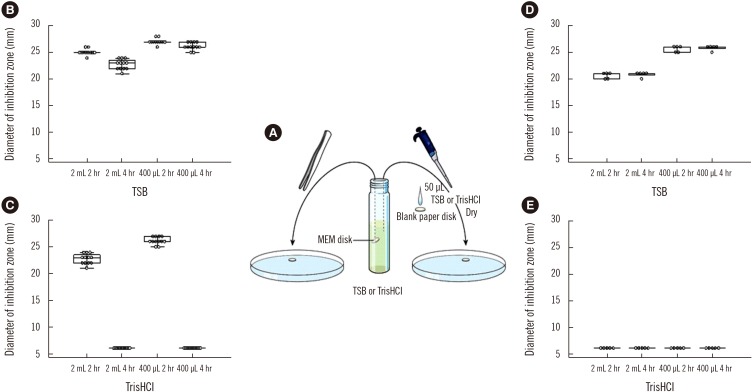1. Dijkshoorn L, Nemec A, Seifert H. An increasing threat in hospitals: multidrug-resistant
Acinetobacter baumannii. Nat Rev Microbiol. 2007; 5:939–951. PMID:
18007677.
2. Peleg AY, Seifert H, Paterson DL.
Acinetobacter baumannii: Emergence of a successful pathogen. Clin Microbiol Rev. 2008; 21:538–582. PMID:
18625687.
3. Poirel L, Nordmann P. Carbapenem resistance in
Acinetobacter baumannii: mechanisms and epidemiology. Clin Microbiol Infect. 2006; 12:826–836. PMID:
16882287.
4. Sunenshine RH, Wright MO, Maragakis LL, Harris AD, Song X, Hebden J, et al. Multidrug-resistant
Acinetobacter infection mortality rate and length of hospitalization. Emerg Infect Dis. 2007; 13:97–103. PMID:
17370521.
5. Queenan AM, Bush K. Carbapenemases: the versatile β-lactamases. Clin Microbiol Rev. 2007; 20:440–458. PMID:
17630334.
6. Pierce VM, Simner PJ, Lonsway DR, Roe-Carpenter DE, Johnson JK, Brasso WB, et al. Modified carbapenem inactivation method for phenotypic detection of carbapenemase production among
Enterobacteriaceae. J Clin Microbiol. 2017; 55:2321–2333. PMID:
28381609.
7. van der Zwaluw K, de Haan A, Pluister GN, Bootsma HJ, de Neeling AJ, Schouls LM. The carbapenem inactivation method (CIM), a simple and low-cost alternative for the Carba NP test to assess phenotypic carbapenemase activity in Gram-negative rods. PLoS One. 2015; 10:e0123690. PMID:
25798828.
8. Walther-Rasmussen J, Høiby N. OXA-type carbapenemases. J Antimicrob Chemother. 2006; 57:373–383. PMID:
16446375.
9. Simner PJ, Opene BN, Chambers KK, Naumann ME, Carroll KC, Tamma PD. Carbapenemase detection among carbapenem-resistant glucose-nonfermenting Gram-negative bacilli. J Clin Microbiol. 2017; 55:2858–2864. PMID:
28701421.
10. CLSI. Performance standards for antimicrobial susceptibility testing. 26th ed. CLSI supplement M100-S26. Wayne, PA, USA: Clinical and Laboratory Standards Institute;2016.
11. CLSI. Performance standards for antimicrobial susceptibility testing. 27th ed. CLSI supplement M100-S27. Wayne, PA, USA: Clinical and Laboratory Standards Institute;2017.
12. CLSI. Performance standards for antimicrobial susceptibility testing. 28th ed. CLSI supplement M100-S28. Wayne, PA, USA: Clinical and Laboratory Standards Institute;2018.
13. CLSI. Test for carbapenemases in Enterobacteriaceae and Pseudomonas aeruginosa. 28th ed. CLSI supplement M100. Wayne, PA: Clinical and Laboratory Standards Institute;2018.
14. Uechi K, Tada T, Shimada K, Kuwahara-Arai K, Arakaki M, Tome T, et al. A modified carbapenem inactivation method, CIMTris, for carbapenemase production in
Acinetobacter and
Pseudomonas species. J Clin Microbiol. 2017; 55:3405–3410. PMID:
28954898.
15. CLSI. Performance standards for antimicrobial susceptibility testing. 20th ed. CLSI supplement M100-S20. Wayne, PA, USA: Clinical and Laboratory Standards Institute;2010.
16. Woodford N, Ellington MJ, Coelho JM, Turton JF, Ward ME, Brown S, et al. Multiple PCR for genes encoding prevalent OXA carbapenemases in
Acinetobacter spp. Int J Antimicrob Agents. 2006; 27:351–353. PMID:
16564159.
17. Bahador A, Raoofian R, Farshadzadeh Z, Beitollahi L, Khaledi A, Rahimi S, et al. The prevalence of
ISAba1 and
ISAba4 in
Acinetobacter baumannii species of different international clone lineages among patients with burning in Tehran, Iran. Jundishapur J Microbiol. 2015; 8:e17167. PMID:
26396712.







 PDF
PDF ePub
ePub Citation
Citation Print
Print



 XML Download
XML Download